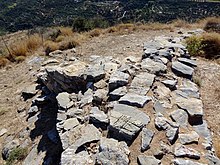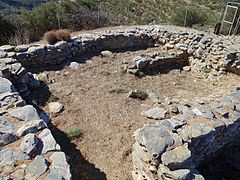Minoan house of Chamaizi
The Minoan House of Chamaizi ( Greek Μινωική οικία Χαμαιζίου Minoiki ikia Chameziou ) is an archaeological excavation site in the northeast of the Greek island of Crete . It is located in the municipality of Sitia in the Lasithi regional district , about 650 meters south of the town of Chamezi , after which it is named. The remains of buildings uncovered on the 501 meter high Souvloto Mouri ( Σουβλωτό Μουρί 'Pointed Hill') date from the early and Middle Minoan period in the 3rd and 2nd millennium BC. Chr.
Location and history
The Minoan house of Chamaizi, which is sometimes also referred to as the "Minoan villa", stood on a hill of a northeastern foothill of the Orno Mountains ( Ορνό Όρος ) near the north coast of Crete. The distance between the building remains and the coast of the Cretan Sea in the northeast is around 3.9 kilometers as the crow flies , and 14.7 kilometers to the Levantic Sea on the south coast of the island. The archaeological site can be reached from the east on a 900 meter long dirt road from the main road between Chamezi and Exo Mouliana. From Souvloto Mouri there is a good view of the bay of Sitia ( Όρμος Σητείας ), on the south side of which stood the Minoan palace of Petras .
The public access to the 30 × 40 meter fenced excavation area of Chamaizi is located in the southeast of the hill. From the prehistoric building only the foundation walls are preserved, the external dimensions of which are 14.50 × 22.20 meters from the Middle Minoan cultural section. It is the only oval building known from the Minoan period to date. The first excavations took place in 1903 under Stephanos Xanthoudides , the results of which he published in 1906. Under the direction of Costis Davaras , the excavation site was cleaned and conserved in 1971, which resulted in new findings.

At the beginning of the 20th century, Duncan Mackenzie assumed that the shape of the building was based on the small rounded top of the hill. This contradicts the fact that earlier structures were outside the Middle Minoan building. A total of three different construction phases from the early Minosan period FM II (approx. 2700 to 2300 BC) were established. Refers to an Early Minoan these structures as a space 2 and northeast located outside the building mittelminoischen, contained three terracotta - figurines and the head of a fourth. The statuettes found in 1903 are dated to the Middle Minoan period between 1900 and 1700 BC due to parallels from the old palace period. Dated. In addition to a found rhyton , a clay offering table and a layer of ash, the figurines were the reason that Nikolaos Plato interpreted Chamaizi as a summit shrine .
As a result of the investigations of 1971 it was concluded that the Minoan house of Chamaizi could not have been a summit sanctuary. The number of artifacts found is too small for that. The finds also came from local pottery and also included fragments of pithoi and loom weights , grindstones , kernas and pestles . Ash deposits were also found in other parts of the building. This supports Xanthoudides' original thesis of a Minoan house with a living area and rooms for food processing, weaving and storage. The place where the figurines were found could have been a local shrine . The beginning of the Middle Minoan phase MM I A (around 2100 BC) is assumed to be the time of the construction of the oval house. It was probably inhabited by a large family or clan.
With the rise of the Palace of Petra and the inclusion of the area of Chamaizi in its sphere of influence in MM II A (until 1800/1700 BC) the settlement ended and the house on the Souvloto Mouri was destroyed. Its development thus resembles that of the rectangular house of Agia Photia on the bay of Sitia. Both buildings had an inner courtyard, which was much smaller in Chamaizi. A special feature of the oval house by Chamaizi is the 3.5 meter deep cistern with a diameter of 1.5 meters in the center of the building , partly carved into the rock and partly walled up with limestone . Rainwater flowed into them from an inward sloping roof. The overflow led out of the building via the southeast exit.
- Excavation site
literature
- Duncan Mackenzie: Cretan Palaces and the Aegean Civilization. IV . In: The Annual of the British School at Athens . tape 14 . British School at Athens, Athens 1908, p. 414-422 (English).

- Ferdinand Noack : Oval house and palace in Crete . A contribution to the early history of the house. Teubner, Leipzig and Berlin 1908, p. 53-67 ( digitized version ).
- Bertha Carr Rider: The Greek House . University Press, Cambridge 1916, Round, Elliptical and Rectangular Forms, pp. 43–44 (English, digitized version ).
- Arthur Evans : The Palace of Minos at Knossos . MacMillan, London 1921, Foundation of Knossian Palace, p. 147–148 (English, digitized ).
- Costis Davaras: The Oval House at Chamaizi Reconsidered . In: Archeologika Analekta Ex Athinon (= Athens Annals of Archeology 5 ). Hellenic Ministry of Culture, Athens 1972, p. 283–288 (English, digitized version ).
- Costis Davaras: Chamaizi . In: Wilson J. Myers, Eleanor E. Myers, Gerald Cadogan (Eds.): The Aerial Atlas of Ancient Crete . University of California Press, Berkeley 1992, ISBN 978-0-520-07382-1 , pp. 78-81 (English).
- Mary Blomberg, Göran Henriksson: The Function of the Minoan Oval House at Chamaizi . In: British Archaeological Reports - International series . tape 1647 . Archaeopress, 2007, ISSN 0143-3067 , p. 15–18 (English, digitized version [PDF; 5.5 MB ]).
- Valeria Lenuzza: "The Whole is a Freak": A Reassessment of the Spatial Organization of the Oval House at Chamaizi, Sitia . In: Kevin T. Glowacki, Natalia Vogeikoff-Brogan (ed.): Stega: The Archeology of Houses and Households in Ancient Crete (= Hesperia Supplements . No. 44 ). The American School of Classical Studies at Athens, Princeton 2011, p. 59–70 (English, digitized version ).
Individual evidence
- ↑ Costis Davaras: Chamaizi . In: Wilson J. Myers, Eleanor E. Myers, Gerald Cadogan (Eds.): The Aerial Atlas of Ancient Crete . University of California Press, Berkeley 1992, ISBN 978-0-520-07382-1 , pp. 78 (English, digitized in the Google book search).
- ↑ Ferdinand Noack : Oval House and Palace in Crete . A contribution to the early history of the house. Teubner, Leipzig and Berlin 1908, p. 53 ( digitized version [accessed January 18, 2017]).
- ↑ a b c d e Chamaizi. Minoan Crete, July 12, 2015, accessed January 18, 2017 .
- ↑ a b Valeria Lenuzza: "The Whole is a freak": A Reassessment of the Spatial Organization of the Oval House at Chamaizi, Siteia . In: Kevin T. Glowacki, Natalia Vogeikoff-Brogan (ed.): Stega: The Archeology of Houses and Households in Ancient Crete (= Hesperia Supplements . No. 44 ). The American School of Classical Studies at Athens, Princeton 2011, p. 64 (English, digitized version [accessed January 18, 2017]).
- ↑ a b c Valeria Lenuzza: "The Whole is a freak": A Reassessment of the Spatial Organization of the Oval House at Chamaizi, Siteia . In: Kevin T. Glowacki, Natalia Vogeikoff-Brogan (ed.): Stega: The Archeology of Houses and Households in Ancient Crete (= Hesperia Supplements . No. 44 ). The American School of Classical Studies at Athens, Princeton 2011, p. 60 (English, digitized version [accessed January 18, 2017]).
- ^ J. Lesley Fitton: The Minoans . Theiss, Stuttgart 2004, ISBN 3-8062-1862-5 , Frühminoisch III and Mittelminoisch IA, p. 48 (English: Peoples of the Past - Minoans . London 2002. Translated by Tanja Ohlsen).
- ^ John C. McEnroe: Architecture of Minoan Crete: Constructing Identity in the Aegean Bronze Age . University of Texas Press, Austin 2010, ISBN 978-0-292-72193-7 , Architectural Experiments and Hierarchical Identity in Late Prepalatial Architecture (c. 2200–1900 BC), pp. 34 (English, digitized in the Google book search).
- ↑ Valeria Lenuzza: "The Whole is a freak": A Reassessment of the Spatial Organization of the Oval House at Chamaizi, Siteia . In: Kevin T. Glowacki, Natalia Vogeikoff-Brogan (ed.): Stega: The Archeology of Houses and Households in Ancient Crete (= Hesperia Supplements . No. 44 ). The American School of Classical Studies at Athens, Princeton 2011, p. 69–70 (English, digitized version [accessed January 18, 2017]).
- ↑ Chamaizi cistern. National Technical University of Athens, accessed January 18, 2017 .
- ↑ Valeria Lenuzza: "The Whole is a freak": A Reassessment of the Spatial Organization of the Oval House at Chamaizi, Siteia . In: Kevin T. Glowacki, Natalia Vogeikoff-Brogan (ed.): Stega: The Archeology of Houses and Households in Ancient Crete (= Hesperia Supplements . No. 44 ). The American School of Classical Studies at Athens, Princeton 2011, p. 66 (English, digitized version [accessed January 18, 2017]).
Web links
- Chamois - Souvloto Mouri. In: Digital Crete: Archaeological Atlas of Crete. Foundation for Research and Technology-Hellas (FORTH), Institute for Mediterranean Studies(English).
- Ruins of Minoan villas and ancient houses (Omalos, Sklavokambos, Trypiti, Chamaizi). (PDF) Scientific Working Group Obertshausen - Mosbach, June 12, 2006, accessed on January 18, 2017 (545.06 KB).
- Oval house at Chamaizi. Ministry of Culture and Sports, 2012, accessed January 18, 2017 .
- Reconstruction of Chamaizi. classconnection, accessed on January 18, 2017 .
- Chamaizi. Minoan Crete, July 12, 2015, accessed January 18, 2017 .
- Chamaizi. The Megalithic Portal, accessed January 18, 2017 .
Coordinates: 35 ° 10 ′ 3.7 ″ N , 26 ° 1 ′ 6.9 ″ E






